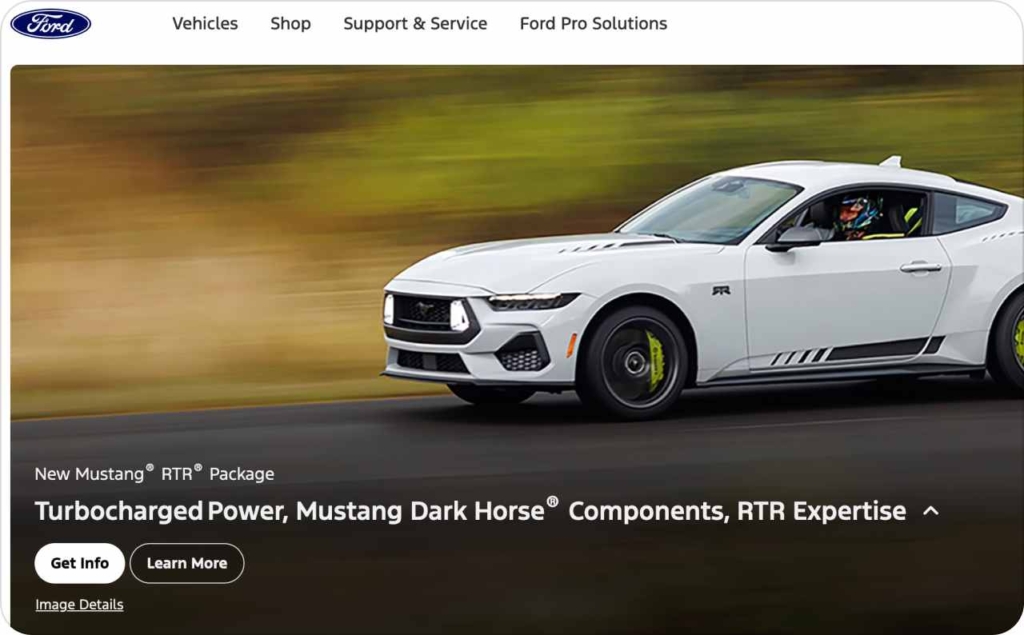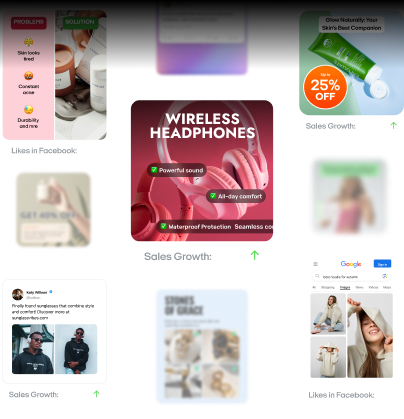Targeted display advertising: 7 practical strategies to boost performance
See how to make targeted display ads work smarter. This guide covers seven practical strategies for better targeting, creative, and performance, plus how Zeely’s AI ad generator makes it all effortless.
Targeted display advertising isn’t just banner inventory anymore. It’s the open-web mix of static and motion banners, native units, and display video you buy through the Google Display Network or programmatic DSPs, built to reach people long before they search. Instead of chasing keywords, these ads follow context, interest, and intent. The IAB projects a 7.3% lift in total ad spend for 2025, showing that brands still trust digital display to move awareness early. When your display targeting works right, audiences feel understood. That’s what separates generic placements from targeted display ads that actually earn attention.

Strategies: A practical playbook you can run this quarter
Modern display performance comes from sharper structure. The best campaigns today move fast, test lean, and focus on measurable intent instead of chasing every impression. Think of this as a quarterly routine you can actually run: clear goals, repeatable steps, and creative that learns as it goes. Each move below turns broad exposure into accountable growth, a simple framework for making targeted display advertising creatives work smarter, not louder.
According to Pew Research, 53% of U.S. adults say they at least sometimes get news from social media, showing that attention on the open web is widespread and that reach-based channels still matter.
1. Start with outcomes, not audiences
Before you build segments or pick placements, define what success actually means. This is where outcome-first planning turns into effective display ad targeting. One clear outcome leads to one clear KPI, whether it’s reach, engagement, or conversions, so every decision around creative, bidding, and frequency ties back to purpose, not guesswork.
Outcome-driven campaigns: Your foundation
Before scaling audiences or experimenting with formats, your campaign must rest on a measurable core. A precise outcome gives creative and media teams a shared direction and keeps performance transparent.
Core elements of outcome-driven targeting include:
- Mapping Outcome → KPI → Constraint → Plan before launch
- Locking one primary KPI per campaign
- Aligning creative and bidding strategy to that KPI
- Setting frequency caps and pacing rules tied to performance goals
- Reviewing results weekly against the same outcome benchmark
For example, campaigns that shifted to a single-KPI structure saw up to a 28% improvement in conversion efficiency across display and video placements. When clarity leads, targeted display ads stop feeling like noise and start working like systems.

Photo source: Rhode
2. Targeting framework: Concepts that keep campaigns sharp
Once your goals are defined, the next step is shaping how your ads actually reach people. This is where display advertising targeting becomes the engine behind every measurable impression. Instead of treating audiences as a single block, these targeting layers, contextual, geographic, demographic, and data-driven, let you deliver relevance at scale.
The four targeting pillars: Your foundation
Before scaling spend or adding new formats, you need a structure that ensures every impression counts. Each layer works best in a specific phase of your funnel, tied to one clear metric.
- Contextual / semantic targeting. Matches your ads with relevant content based on meaning and topic
- Geo / daypart targeting. Delivers ads by region or time of day to align with intent moments
- Demographic / behavioral targeting. Uses data like age, interests, or browsing habits to focus on high-propensity buyers
- First-party / lookalike targeting. Expands from your own data to find similar users across platforms
For example, advertisers who layered contextual and first-party data saw up to a 22% lift in qualified traffic compared to campaigns using demographic filters alone. This is proof that smart structure beats broad reach every time.
3. Execution tactics: Turning strategy into control
Once your framework is set, execution is where control becomes craft. These are the day-to-day adjustments that make display ads targeting perform at scale, the switches you toggle to protect budget, refine reach, and keep your ads aligned with brand safety. The goal isn’t to automate everything; it’s to stay close enough to the data to steer it.
Display relevance starts with how you read context. Some campaigns work best at the page level, matching ads directly to specific articles or topics. Others perform better when they use semantic graphs, identifying related subjects instead of relying on exact keyword matches. Negative keyword lists are your defensive layer, removing content that doesn’t serve your message or could harm brand tone. For banner-heavy campaigns, running targeted banner ads on curated placements reduces wasted impressions and keeps creative visible where it matters.
Retargeting and geography shape how memory and timing interact. Site, product, cart, and CRM retargeting each serve a different role — from re-engaging browsers to nudging near-buyers. Adjusting recency windows helps balance urgency with fatigue. Geo layers handle proximity: use geo-fencing for precision around events or local activations, and geo-targeting for scalable regional awareness.
Targeting controls worth operationalizing:
- Maintain suppression lists to exclude converters or internal audiences
- Apply frequency discipline to prevent overexposure and budget waste
Quality safeguards to standardize:
- Set clear brand suitability parameters
- Curate inventory through PMPs or premium deals to prioritize credible publishers
When these two lists stay active, execution moves beyond setup. You’re orchestrating campaigns, keeping every impression intentional and every metric accountable.

Photo source: TACO NACO KC
4. Channel & inventory choices: Where these strategies run best
Even the sharpest targeting won’t work without the right stage. Channels define how your message travels and how much control you keep over data, spend, and quality. In today’s ecosystem, targeted digital display advertising spans multiple environments, from Google Display Network to premium DSPs, each offering its own balance between reach, precision, and creative flexibility. Think of it as programmatic reach distributed across open exchanges, curated networks, and walled gardens.
The key is knowing when speed matters more than scale, or when quality outweighs cost. A well-structured mix ensures that no audience segment feels overexposed while your KPIs stay measurable across formats.
When to use which:
| Platform / Environment | Best for | Practical use case |
| Google Display Network | Quick setup and immediate reach | Launching fast campaigns with broad contextual coverage |
| Demand-side platforms | Scale, inventory quality, and data control | Running multi-exchange buys, layering first-party data, or testing PMPs |
| Native & In-app inventory | Seamless user experience and engagement | Blending brand messaging within publisher content or mobile apps |
| YouTube / Connected TV | High-attention video placements | Extending display storytelling into sight, sound, and motion |
Each environment amplifies your strategy in a different way — GDN for momentum, DSPs for control, native for resonance, and YouTube or CTV for reach that feels human. When balanced, they turn a fragmented ad plan into a single, visible story across screens.
5. Creative that matches the signal
Relevance is about changing intent response. In strong campaigns, creative flexes to match signals, not pixels. A user scrolling a news feed behaves differently from one reading a product review, so the message needs to follow their context, not your format.
Every asset should meet technical best practices: approved IAB sizes, polite load for smooth rendering, and clear mobile touch for following targeted mobile advertising strategies. Keep your testing grid simple, 2 angles × 2 visuals × 1 CTA per audience, enough to surface learnings without overloading production.
Creative checks to operationalize:
- Adapt copy and visuals to the audience’s funnel stage — awareness, consideration, or conversion
- Build motion and static variants that share the same core message but differ in hook and tone
- Always include descriptive alt text, such as “target banner ads featuring product demo and CTA button”, to support accessibility and SEO
- Refresh visuals on a set cadence to prevent fatigue and track which signal combinations perform best
When creative mirrors real user intent, your targeted mobile advertising stop interrupting and start resonating, translating data into human relevance.

Photo source: Ford
6. Measurement that stays honest
The numbers only matter if they tell the truth. In targeted display advertising, performance means more than a high click-through rate, it means understanding how quality, engagement, and efficiency connect to real outcomes. Every campaign in targeted digital display advertising needs a scorecard built for insight, not ego.
Start with quality metrics: monitor viewability and filter for invalid traffic to ensure impressions are legitimate and visible. Then look at engagement signals, CTR, interaction rate, and dwell time, to gauge whether people are paying real attention. From there, track efficiency using CPM and CPC, keeping both aligned with pacing and reach goals.
When evaluating outcomes, measure CPA and ROAS with post-view attribution windows to account for delayed conversions. Add incrementality tests to prove what your campaigns truly drive, and update your reporting cadence to reflect learning speed.
Honest measurement keeps display ad targeting accountable. It refines them, turning raw performance data into repeatable, trustworthy growth.
7. Optimization sprints
Optimization in targeted display advertising is a steady rhythm. The highest-performing campaigns evolve through short, focused sprints that refresh creative, rebalance spend, and protect efficiency without restarting from scratch. Each sprint should have one goal, one test, and one measurable improvement.
Start with fatigue fixes: rotate creative variants, update CTAs, and pause underperforming visuals before they waste impressions. Then move to scaling smartly, expand reach only when your core audience consistently engages. Maintain retargeting sanity by limiting frequency, refining recency windows, and prioritizing high-intent users within your targeted digital display advertising mix.
Inventory cleanup keeps your spend healthy: remove low-viewability placements, recheck PMPs, and rebalance budgets toward high-performing exchanges. Small bid and pacing nudges, such as raising bids on proven audiences or slowing delivery midweek, often drive more stable efficiency than big resets.
When you treat optimization as a recurring process, your data starts compounding. Each sprint tightens creative alignment, sharpens performance, and incrementally refines display targeting, turning daily tweaks into lasting lift.
Reasons to use an AI ad generator for your targeted display ads
Running ads shouldn’t feel like a full-time job. Yet for most small businesses, it often does, juggling creative, budgets, and platforms while trying to stay visible. That’s where Zeely, an AI-powered ad tool built for SMBs, marketers, and e-commerce brands, changes the equation. It’s more than an AI generator for ads, it’s a business growth app that helps you plan, build, and optimize display campaigns in minutes.
Common pain points and how Zeely solves them:
- Low budget ads → Zeely’s AI optimizes spend automatically, so every dollar reaches the right audience without waste
- No design skills → The platform builds scroll-stopping creatives from your product link, no designer required
- Campaign complexity → Instead of juggling multiple dashboards, Zeely simplifies setup across Google, Meta, and open-web networks in one place
- Low conversion rates → Smart testing and AI-driven variants identify what actually converts, improving performance over time
- Scaling problems → Zeely auto-adjusts campaigns as you grow, managing bids, audiences, and creatives dynamically
- Wasted ad spend → Transparent metrics and AI recommendations keep budgets focused on what performs
Each feature is built for speed and clarity, because great marketing shouldn’t depend on technical skill or a big team. Zeely removes the noise, automates the hard parts, and delivers campaigns that look professional and perform predictably.
In short, it’s the tool that makes targeted display ads effortless. With Zeely, cost-efficiency, accessibility, and measurable results are the baseline for growing your business with confidence. Ready to simplify your advertising? Start using Zeely’s AI ad generator today, create your first campaign, test real results, and see how easy business growth can be.
Also recommended



